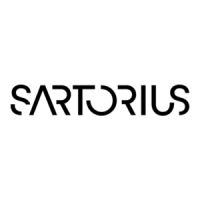Do you have a question about the Sartorius Talent TE612-L and is the answer not in the manual?
Requirement for completed service courses and prohibition of unauthorized repair work.
Steps to access and navigate the operating menu, including unlocking read-only mode.
Options for restoring factory default settings and resetting SBI mode.
Ensuring write-protect is set after BPI mode operation to return to SBI mode.
Procedure for checking overload stops, requiring service software and BPI mode.
Procedure for adapting the strain-gauge load receptor voltage using a DVM and balancing resistor R29.
Table correlating zero-point offset voltage ranges with specific R29 resistor values.
Procedure for checking repeatability using test weights and calculating standard deviation 'S'.
Procedure for checking repeatability using test weights and calculating standard deviation 'S'.
Procedure for checking off-center loading error by placing weights at different positions on the pan.
Method for adjusting off-center load error by filing a thin part on the load receptor.
Steps for adjusting the span using the operating menu and calibration weights.
Steps for adjusting the span using the operating menu and calibration weights, including tolerance checks.
Procedure for checking linearity using 4-g steps and comparing with tolerance ranges.
Procedure for adjusting linearity using service software and BPI mode.
Procedure for adjusting linearity using service software and BPI mode.
Steps for adjusting off-center loading error using 3-point measurement and adjustment screws.
Detailed procedure for adjusting off-center error using 3-point measurement and screws, including direction of turns.
Cautionary note about adjusting off-center loading error at thin sites on the upper guide with an angled file.
Steps for reading data, replacing the main PCB, and programming the new PCB.
Requirement for completed service courses and prohibition of unauthorized repair work.
Steps to access and navigate the operating menu, including unlocking read-only mode.
Options for restoring factory default settings and resetting SBI mode.
Ensuring write-protect is set after BPI mode operation to return to SBI mode.
Procedure for checking overload stops, requiring service software and BPI mode.
Procedure for adapting the strain-gauge load receptor voltage using a DVM and balancing resistor R29.
Table correlating zero-point offset voltage ranges with specific R29 resistor values.
Procedure for checking repeatability using test weights and calculating standard deviation 'S'.
Procedure for checking repeatability using test weights and calculating standard deviation 'S'.
Procedure for checking off-center loading error by placing weights at different positions on the pan.
Method for adjusting off-center load error by filing a thin part on the load receptor.
Steps for adjusting the span using the operating menu and calibration weights.
Steps for adjusting the span using the operating menu and calibration weights, including tolerance checks.
Procedure for checking linearity using 4-g steps and comparing with tolerance ranges.
Procedure for adjusting linearity using service software and BPI mode.
Procedure for adjusting linearity using service software and BPI mode.
Steps for adjusting off-center loading error using 3-point measurement and adjustment screws.
Detailed procedure for adjusting off-center error using 3-point measurement and screws, including direction of turns.
Cautionary note about adjusting off-center loading error at thin sites on the upper guide with an angled file.
Steps for reading data, replacing the main PCB, and programming the new PCB.
| Maximum Capacity | 610 g |
|---|---|
| Capacity | 610 g |
| Readability | 0.01 g |
| Pan Size | 130 mm |
| Calibration | External |
| Display | LCD |
| Interface | RS-232 |
| Power Supply | AC Adapter |
| Operating Temperature | 10°C to 30°C |











